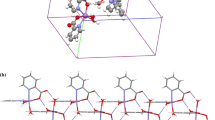Abstract
The reactions of 6-phosphononicotinic acid (pnaH3) and metal salts result in three new compounds, namely, M(pnaH)-(H2O)3·H2O [M = Co(II) (1), Ni(II) (2), Zn(II) (3)]. These compounds are isostructural and contain 21 helical chains made up of corner-sharing {MO5N} octahedra and {PO3C} tetrahedra. The chains are further connected by extensive hydrogen bonds to form a three-dimensional supramolecular structure. Magnetic studies reveal that dominant antiferromagnetic interactions are mediated in both 1 and 2. Interestingly the dehydrated compound 1 shows metamagnetic behavior at low temperature.
Similar content being viewed by others
References
Clearfield A. Metal phosphonate chemistry. Prog Inorg Chem, 1998, 47: 371–510
Bao SS, Ma LF, Wang Y, Fang L, Zhu CJ, Li YZ, Zheng LM. Anion-directed self-assembly of lanthanide-notp compounds and their fluorescence, magnetic, and catalytic properties. Chem Eur J, 2007, 13: 2333–2343
Ma LQ, Abney C, Lin WB. Enantioselective catalysis with homochiral metal-organic frameworks. Chem Soc Rev, 2009, 38: 1248–1256
Mao JG. Structures and luminescent properties of lanthanide phosphonates. Coord Chem Rev, 2007, 251: 1493–1520
Liu XG, Zhou K, Dong J, Zhu CJ, Bao SS. Homochiral lanthanide phosphonates with brick-wall-shaped layer structures showing chiroptical and catalytical properties. Inorg Chem, 2009, 48: 1901–1905
Monot J, Petit M, Lane SM, Guisle I, Léger J, Tellier C, Talham DR, Bujoli B. Towards zirconium phosphonate-based microarrays for probing DNA-protein interaction: Critical influence of the location of the probe anchoring groups. J Am Chem Soc, 2008, 130: 6243–6251
Amalric J, Mutin PH, Guerrero G, Ponche A, Sotto A, Lavigne JP. Phosphonate monolayers functionalized by silver thiolate species as antibacterial nanocoatings on titanium and stainless steel. J Mater Chem, 2009, 19: 141–149
Maheswaran S, Chastanet G, Teat SJ, Mallah T, Sessoli R, Wernsdorfer W, Winpenny REP. Phosphonate ligands stabilize mixed-valent {MnIII 20−x MnII x clusters with large spin and coercivity. Angew Chem Int Ed, 2005, 44: 5044–5048
Ma YS, Song Y, Zheng LM. Tridecanuclear and docosanuclear manganese phosphonate clusters with slow magnetic relaxation. Inorg Chem, 2007, 46: 5459–5461
Yang BP, Prosvirin AV, Guo YQ, Mao JG. Co[HO2C(CH2)3NH-(CH2PO3H)2]2: A new canted antiferromagnet. Inorg Chem, 2008, 47: 1453–1459
Cao DK, Xie XJ, Li YZ, Zheng LM. Copper diphosphonates with zero-, one- and two- dimensional structures: Ferrimagnetism in layer compound Cu3(ImhedpH)2·2H2O [ImhedpH4 = (1-C3H3N2)CH2C(OH)-(PO3H2)2]. Dalton Trans, 2008, 5008–5015
Li JT, Keene TD, Cao DK, Decurtins S, Zheng LM. [M(OOCC6H4-PO3H)(H2O)] (M(II) = Mn, Co, Ni): Layered metal phosphonates showing variable magnetic behavior. CrystEngComm, 2009, 11: 1255–1260
Wang PF, Bao SS, Zhang SM, Cao DK, Liu XG, Zheng LM. Pillared layered metal phosphonates showing field-induced magnetic transitions. Eur J Inorg Chem, 2010, 895–901
Yang TH, Liao Y, Zheng LM, Dinnebier RE, Su YH, Ma J. Tuning the field-induced magnetic transition in a layered cobalt phosphonate by reversible dehydration-hydration process. Chem Commun, 2009, 3023–3025
Palii AV, Reu OS, Ostrovsky SM, Klokishner SI, Tsukerblat BS, Sun ZM, Mao JG, Prosvirin AV, Zhao HH, Dunbar KR. A highly anisotropic cobalt(II)-based single-chain magnet: Exploration of spin canting in an antiferromagnetic array. J Am Chem Soc, 2008, 130: 14729–14738
Bernot K, Luzon J, Sessoli R, Vindigni A, Thion J, Richeter S, Leclercq D, Larionova J, Lee A. The canted antiferromagnetic approach to single-chain magnets. J Am Chem Soc, 2008, 130: 1619–1627
Loran JS, Naylor RA, Williams A. Direct N-methylation of 2-pyridylphosphonic acids by diazomethane. J Chem Soc, Perkin Trans, 1976, 1444–1447
Kahn O. Molecular Magnetism. New York: Wiley-VCH, 1993
SAINT, Program for Data Extraction and Reduction, Siemens Analytical X-ray Instruments, Madison, WI, 1994–1996
SHELXTL (version 5.0), Reference Manual, Siemens Industrial Automation, Analytical Instruments, Madison, WI, 1995
Wang XY, Wang ZM, Gao S. Detailed magnetic studies on Co(N3)2(4-acetylpyridine)2: A weak-ferromagnet with a very big canting angle. Inorg Chem, 2008, 47: 5720–5726
Author information
Authors and Affiliations
Corresponding author
Electronic supplementary material
Rights and permissions
About this article
Cite this article
Wang, P., Duan, Y. & Zheng, L. One-dimensional metal phosphonates based on 6-phosphononicotinic acid: A structural and magnetic study. Sci. China Chem. 53, 2112–2117 (2010). https://doi.org/10.1007/s11426-010-4097-6
Received:
Accepted:
Published:
Issue Date:
DOI: https://doi.org/10.1007/s11426-010-4097-6




